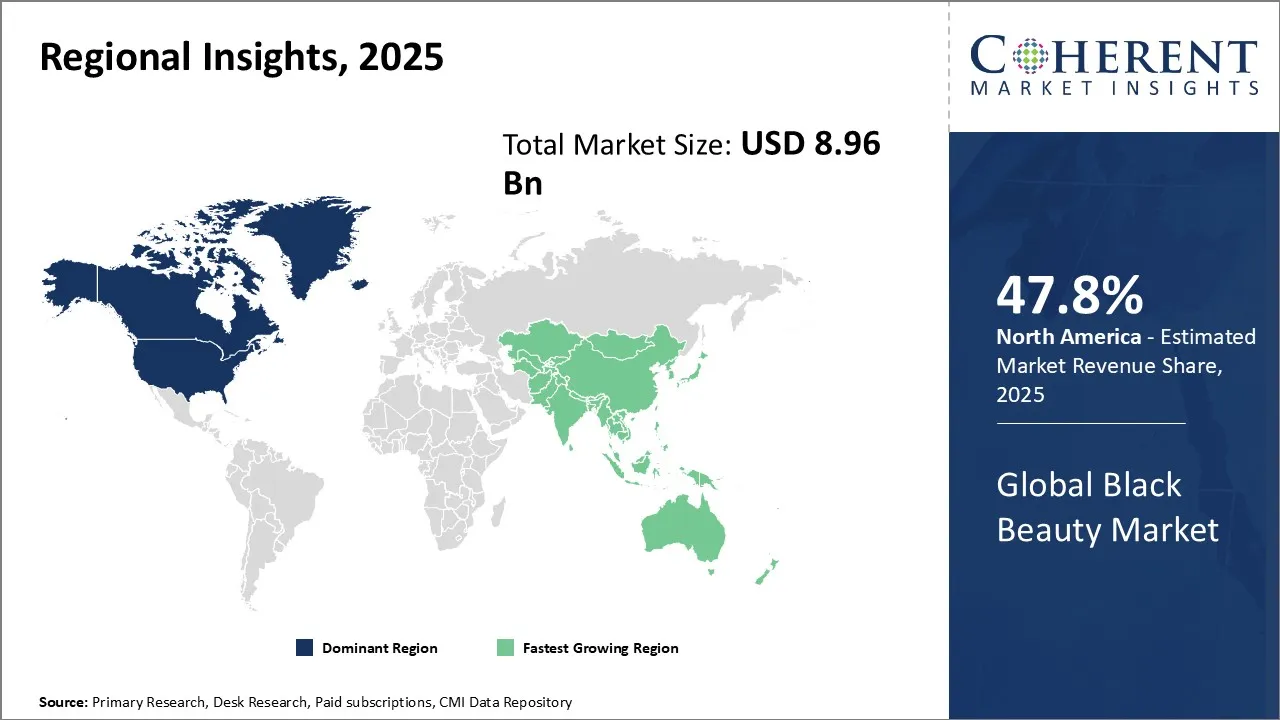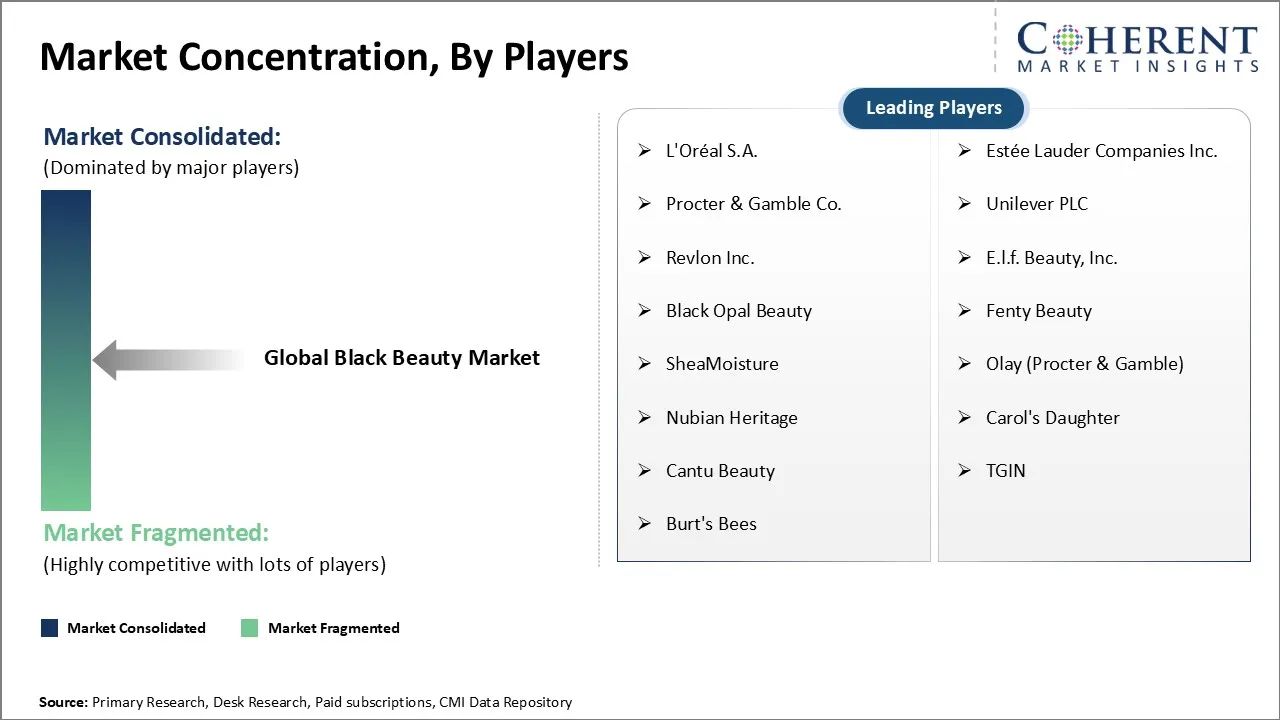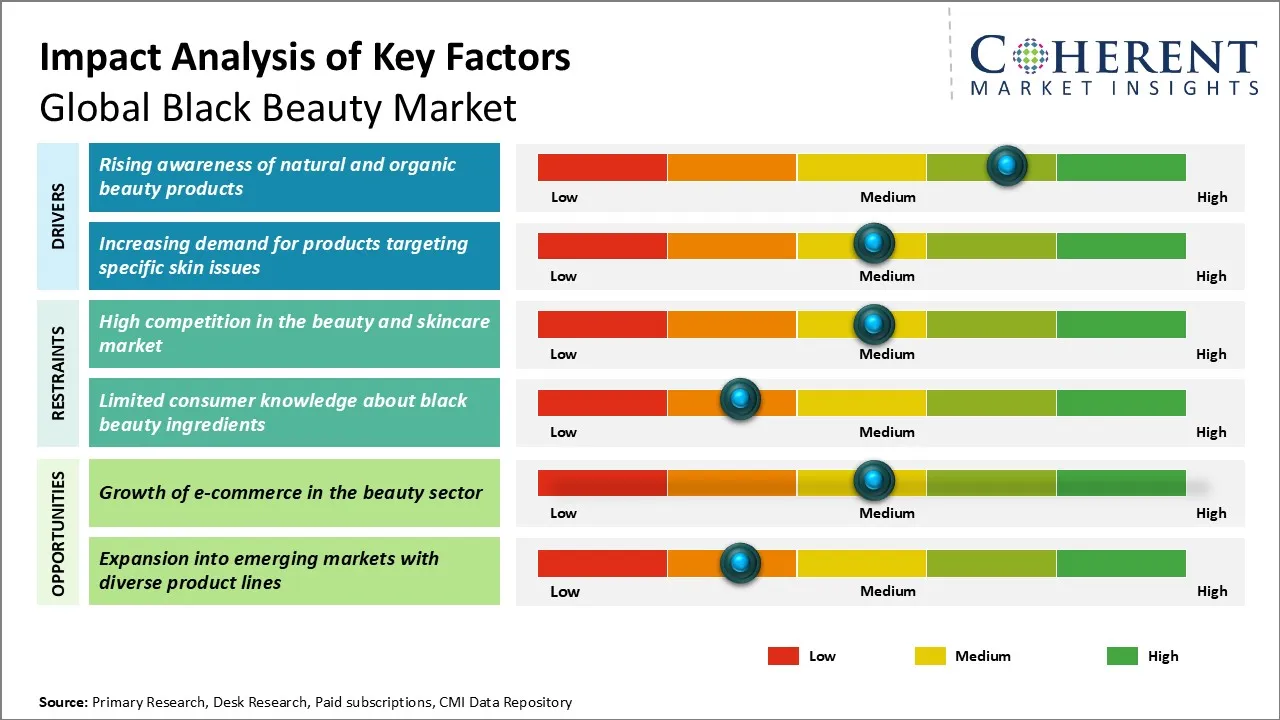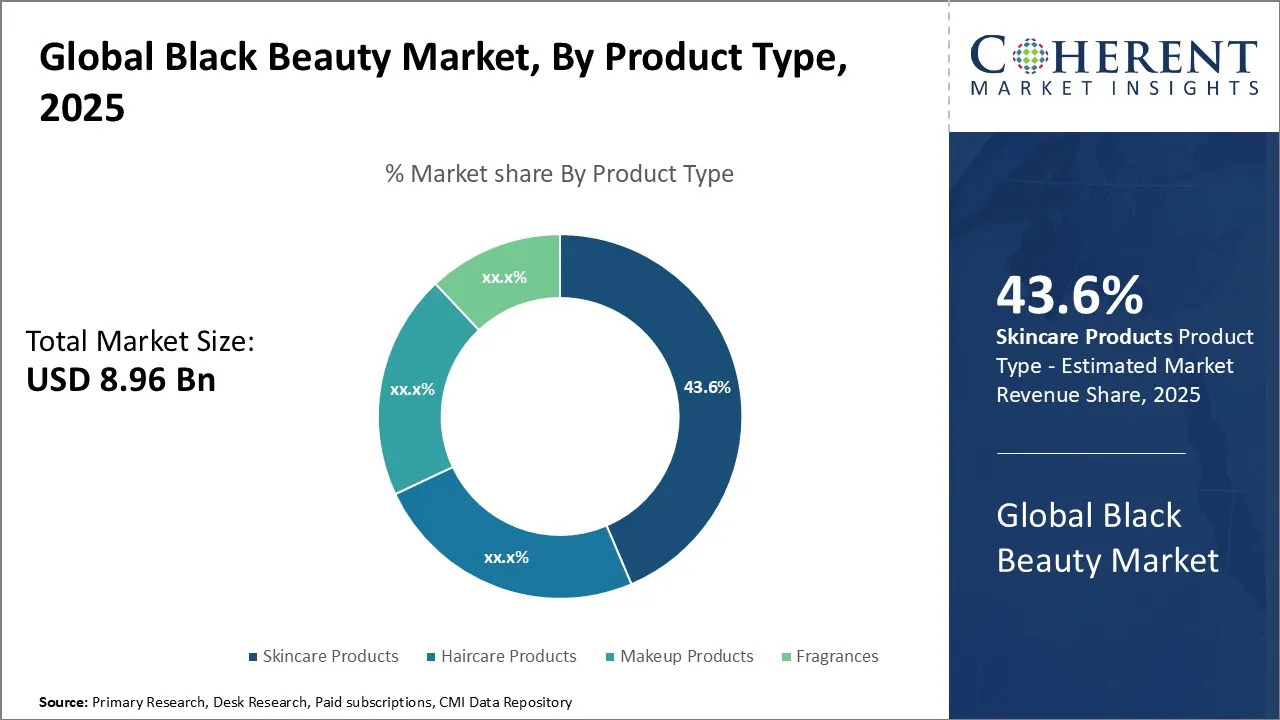Global Black Beauty Market Size and Forecast – 2025-2032
The Global Black Beauty Market is estimated to be valued at USD 8.96 Bn in 2025 and is expected to reach USD 23.11 Bn by 2032, exhibiting a compound annual growth rate (CAGR) of 14.5% from 2025 to 2032.
Key Takeaways of the Black Beauty Market :
- The skincare products segment is expected to account for 43. 6% of the global Black beauty market in 2025.
- The activated charcoal segment is projected to capture 39. 5% of the market in 2025.
- The online retail segment is expected to hold 34. 7% share of distribution channels in 2025.
- North America is set to lead the global Black beauty market in 2025 with a 47. 8% share, driven by the increasing demand for inclusive beauty products and the rising awareness around diversity and representation in the beauty industry. Asia Pacific, with a 13.2% share in 2025, will be the fastest-growing region, fueled by the growing influence of social media, increased consumer demand for natural and organic beauty products, and the region's expanding middle class.
Market Overview:
Brands are increasingly innovating to cater to the unique skincare and haircare needs of Black individuals, developing products that address various skin tones, textures, and hair types. This shift towards inclusivity reflects a broader demand for representation in beauty. Additionally, the rise of social media influencers and digital marketing has significantly boosted product visibility and consumer engagement. Natural and organic ingredients are gaining popularity, aligning with the growing preference for sustainable and health-conscious beauty products and personal care products, further propelling market expansion.
Currents Events and their Impact
|
Current Events |
Description and its impact |
|
L’Oréal’s acquisition of Color Wow |
|
|
Rise of multiracial consumer influence |
|
Uncover macros and micros vetted on 75+ parameters: Get instant access to report
Black Beauty Market Insights, By Product Type - Skincare Products Drive Dominance in the Black Beauty Market through Tailored Solutions and Natural Ingredients
The skincare products segment is expected to contribute 43.6% share of the global Black beauty market in 2025, owing to the growing demand for customized and culturally relevant skincare solutions targeted specifically at the unique needs of Black consumers. The increasing awareness around the diverse skin types and conditions frequently experienced by Black individuals—such as hyperpigmentation, uneven skin tone, dryness, and sensitivity—has fueled consumer preference for specialized skincare products designed to address these challenges effectively.
Brands, such as Fenty Beauty, are responding by formulating products that focus on brightening, nourishing, and protecting the skin while emphasizing natural and organic ingredients that align with consumer expectations for clean and ethical beauty.
Black Beauty Market Insights, By Ingredient - Activated Charcoal as a Key Ingredient Harnesses Natural Detoxification Trends
Activated charcoal segment is projected to hold 39.5% share of the market in 2025, due to its multifunctional properties and growing consumer trust in detoxifying beauty solutions. The ingredient’s ability to deeply cleanse pores, absorb impurities, and balance oil production resonates particularly well within the Black beauty market, where concerns such as acne, excess oil, and clogged pores are prevalent. Activated charcoal products are increasingly favored for their potent purification effects without stripping the skin of essential moisture, aligning with the demand for effective yet gentle skin care products options.
Black Beauty Market Insights, By Distribution Channel - Online Retail Channels Propel Black Beauty Accessibility and Consumer Engagement
The online retail segment is expected to command 34.7% share of distribution channels in the global Black beauty market in 2025, due to the increasing preference for convenient, accessible, and inclusive shopping experiences. Digital platforms offer unparalleled reach, enabling consumers from diverse geographic locations, including underserved and niche markets, to access an expansive variety of Black beauty products tailored specifically to their needs. This widespread availability through e-commerce empowers consumers to discover and experiment with brands and ingredients suited to their individual preferences, often supported by detailed online reviews and community discussions.
Regional Insights:

To learn more about this report, Download Free Sample
North America Black Beauty Market Analysis and Trends
The North America region is projected to lead the market with a 47.8% share in 2025, driven by a well-established market ecosystem, advanced research and development capabilities, and a strong presence of key industry players. Consumer awareness around diversity and representation has historically been high, fueling the demand for specialized Black beauty products.
The region benefits from supportive government policies promoting innovation within the cosmetics and personal care sectors, as well as strict regulations ensuring product safety and quality. Several major companies headquartered here, such as Procter & Gamble, Johnson & Johnson, and L’Oréal USA, have invested heavily in Black beauty lines, contributing significantly to market growth. The robust retail infrastructure and e-commerce penetration further enhance accessibility of these products. Additionally, North America’s multicultural population structure creates a sustained demand for diverse beauty formulations, reinforcing its market leadership.
Asia Pacific Black Beauty Market Analysis and Trends
The Asia Pacific region is expected to exhibit the fastest growth in the market contributing 13.2% share in 2025, driven by increasing awareness about ethnic beauty needs and expanding urban middle-class populations with higher disposable income. The market expansion is supported by evolving consumer preferences and the introduction of tailored products that cater to the unique hair and skin care requirements of black and mixed-race communities. Government initiatives encouraging foreign investments and trade liberalization have attracted global and local brands to boost their presence in this region.
Countries like India and China have witnessed a surge in influencer and celebrity endorsements that promote Black beauty standards, expanding market reach. Notable players such as Unilever, L’Oréal, and local brands like Honasa Consumer Limited in India play pivotal roles by launching diverse product lines designed specifically for ethnic hair textures and complexions. Moreover, the growing digital ecosystem and social media engagement fuel consumer education and product trials, accelerating market growth.
Black beauty Market Outlook for Key Countries
U.S. Black Beauty Market Trends
The U.S. remains at the forefront of the Black beauty market due to its diverse population and mature market ecosystem. Major companies like SheaMoisture (part of Unilever), Carol's Daughter (L’Oréal), and Fenty Beauty (LVMH) have revolutionized the market by fostering inclusivity through extensive product lines. The U.S. also benefits from strong retail chains and online platforms fostering direct-to-consumer approaches, while government regulations ensure ingredient transparency and safety. Consumer advocacy and cultural movements further bolster demand, ensuring ongoing innovation and market penetration.
Brazil Black Beauty Market Trends
Brazil Black beauty market has grown robustly due to its large Afro-Brazilian population, which drives the demand for products catering to textured hair and darker skin tones. National companies like Beleza Natural have significantly influenced the market landscape, creating a strong foundation for beauty standards embracing natural hair textures.
A key player in this market is Beleza Natural, which has made a notable contribution by popularizing natural hair textures and promoting beauty standards that embrace Afro-Brazilian identities. The company’s inclusive approach, focusing on hair care solutions designed specifically for curly and textured hair, has reshaped the beauty landscape in Brazil.
India Black Beauty Market Trends
Increasing inclusivity initiatives by multinational companies such as L’Oréal and Unilever have introduced product lines geared towards darker skin tones and textured hair types, meeting a growing demand for diverse beauty solutions. Government support for 'Make in India' initiatives and ease of doing business reforms have made the market attractive for both global and local players, including brands like Mamaearth, which emphasize natural ingredients and sustainability.
South Africa Black Beauty Market Trends
South Africa serves as a key gateway market for Black beauty in Africa, driven by a well-established urban consumer base and strong local brands such as Afribeauty and Mzuri Cosmetics. The country’s regulatory framework ensures product safety and quality, while government initiatives support empowerment programs within the cosmetics industry. Multinational companies including Revlon and L’Oréal have established operations here to tap into the deep-rooted cultural appreciation for personal grooming and skin health. Retail channels ranging from specialty stores to e-commerce play a crucial role in market accessibility.
End User Feedback and Unmet Needs: Black Beauty Market
Positive User Experience
One positive example of user satisfaction comes from the growing success of Beleza Natural, a leading beauty brand in Brazil. Its products, which are specifically formulated for Afro-Brazilian hair and skin, have received glowing feedback for their effectiveness and inclusivity. Users have praised the brand’s hydrating hair care line, which integrates natural oils, such as coconut and shea butter, into its formulations. Consumers highlight the product’s ability to enhance curl definition and promote hair health without causing dryness or frizz, which is a common challenge faced by those with textured hair.
User Concerns and Limitations
However, despite the success stories, there are significant challenges reported by many end-users, particularly related to product accessibility and affordability. A frequent concern is the high price point of premium Black beauty products, which often limits their accessibility to lower-income communities. For example, a popular luxury brand focused on textured hair care has been criticized for its expensive pricing strategy, which excludes a large portion of potential users who cannot afford these products on a regular basis.
Market Players, Key Development, and Competitive Intelligence:

To learn more about this report, Download Free Sample
Key Developments:
- In September 2024, Glossier awarded USD 50,000 grants to four Black-owned beauty brands as part of its ongoing efforts to support emerging entrepreneurs and promote diversity in the beauty industry. Launched in 2020, the Glossier Grant Programme provides funding and mentorship to help Black-founded businesses grow and compete effectively. At this year’s Beauty Expo, Glossier also introduced a new USD 100,000 Alumni Award designed to help a past grantee further scale their operations.
- In June 2024, Procter & Gamble and IMAN Cosmetics, Beauty Care, and Aromas entered into a strategic partnership. The renowned brand once again broke with convention through this licensing and marketing agreement. As a result, the products are now available at leading retailers, including Amazon, Walmart, Target, Walgreens, and Drugstore Reader.
- In March 2024, Urban Hydration introduced its organic, high-performance, and affordable beauty and haircare products, setting new standards in the industry. Now easily accessible on Amazon, these offerings make it simple to refresh your beauty regimen.
Top Strategies Followed by Global Black Beauty Market Players
- Established players: Leading players in this market invest heavily in research and development (R&D) to innovate high-performance and premium products that meet evolving consumer demands. Such innovation often focuses on enhancing product formulation, durability, and multi-functionality, positioning their brands as market leaders in quality and effectiveness.
- For example, L’Oréal’s launch of the Lancôme Teint Idole Ultra Wear Foundation was driven by extensive R&D to create long-lasting, inclusive shades tailored to diverse skin tones, including deeper complexions. Such innovation often focuses on enhancing product formulation, durability, and multi-functionality, positioning their brands as market leaders in quality and effectiveness.
- Mid-level players in the global Black beauty market primarily focus on balancing affordability with quality to capture the price-sensitive segment of consumers. These companies develop cost-effective solutions and product lines that offer satisfactory performance while remaining accessible to a wider audience. Their strategy revolves around optimizing production methods and supply chains to reduce costs without significantly compromising product quality.
- For instance, in March 2025, Carol’s Daughter partnered with Target to broaden retail access while maintaining competitive pricing. Such partnerships improve production capabilities and accelerate the adoption of new technologies, such as advanced preservation systems that extend shelf life.
- Small-scale players in the Black beauty arena tend to differentiate themselves by focusing on niche products or specialized features that are often overlooked by larger competitors. This segment emphasizes innovation through the adoption of cutting-edge technologies such as natural and organic ingredients, personalized formulations, or sustainable packaging solutions.
- For example, Mented Cosmetics carved a niche by creating nude lipsticks designed specifically for darker skin tones, an underserved category in the mainstream market.
Market Report Scope
Black beauty Market Report Coverage
| Report Coverage | Details | ||
|---|---|---|---|
| Base Year: | 2024 | Market Size in 2025: | USD 8.96 Bn |
| Historical Data for: | 2020 To 2024 | Forecast Period: | 2025 To 2032 |
| Forecast Period 2025 to 2032 CAGR: | 14.5% | 2032 Value Projection: | USD 23.11 Bn |
| Geographies covered: |
|
||
| Segments covered: |
|
||
| Companies covered: |
L'Oréal S.A., Estée Lauder Companies Inc., Procter & Gamble Co., Unilever PLC, Revlon Inc., E.l.f. Beauty, Inc., Black Opal Beauty, Fenty Beauty, SheaMoisture, Olay (Procter & Gamble), Nubian Heritage, Carol's Daughter, Cantu Beauty, TGIN, and Burt's Bees |
||
| Growth Drivers: |
|
||
| Restraints & Challenges: |
|
||
Uncover macros and micros vetted on 75+ parameters: Get instant access to report
Black Beauty Market Dynamics

To learn more about this report, Download Free Sample
Black Beauty Market Driver - Rising Awareness of Natural and Organic Beauty Products
The increasing consumer preference towards natural and organic beauty products is a significant driver within the global Black beauty market. As individuals become more health-conscious and environmentally aware, there is a growing shift away from synthetic ingredients and harsh chemicals traditionally found in beauty formulations. This change is particularly pronounced in the Black beauty segment, where customers seek products that cater to specific hair and skin needs without compromising safety or sustainability.
For example, Fenty Beauty, founded by Rihanna, has made waves not only in its inclusive color range but also in its use of ingredients that promote skin health. The Fenty Skin line includes products like the Total Cleanser and Hydra Vizor Invisible Moisturizer, which are formulated with clean ingredients, such as green tea, fig, and Vitamin C, emphasizing both beauty and skincare.
Black Beauty Market Opportunity - Growth of E-commerce in the Beauty Sector
The rapid expansion of e-commerce presents a significant opportunity for the global Black beauty market, transforming how consumers discover, access, and purchase beauty products tailored to Black consumers. Increasing internet penetration and smartphone adoption worldwide have facilitated easier access to online platforms, enabling brands to reach a broader and more diverse customer base beyond traditional retail channels. E-commerce platforms provide a convenient, personalized shopping experience, often supported by user reviews, influencer endorsements, and virtual consultations, which are particularly valuable in the Black beauty segment where product efficacy and suitability play critical roles.
For example, Target, Walmart, and Ulta Beauty have significantly expanded their online assortments of Black beauty brands, with dedicated sections and marketing campaigns for multicultural beauty.
Analyst Opinion (Expert Opinion):
- The Black beauty market is witnessing notable growth, fueled by rising consumer interest in premium beauty products and the increasing demand for high-quality, natural ingredients. Companies like Fenty Beauty and Black Opal are leading the way with innovative formulations that cater specifically to diverse skin tones, addressing a long-standing gap in the beauty industry.
- Recent conferences, such as the Beautycon Festival (2023) and the Cosmetics & Personal Care Conference (2022), have highlighted discussions around inclusivity and representation, showcasing brands that are successfully launching products tailored to the needs of Black consumers. These events have also spotlighted the importance of ethical sourcing and sustainability in product development. As consumers increasingly seek brands that reflect their identities and values, the Black beauty market is well-positioned for robust expansion, driven by innovations that align with both cultural relevance and quality expectations.
Market Segmentation
- Product Type Insights (Revenue, USD Bn 2020 - 2032)
-
- Skincare Products
- Haircare Products
- Makeup Products
- Fragrances
- Ingredient Insights (Revenue, USD Bn, 2020 - 2032)
-
- Activated Charcoal
- Black Seed Oil
- Black Tea Extract
- Others
- Distribution Channel Insights (Revenue, USD Bn, 2020 - 2032)
-
- Online Retail
- Supermarkets/Hypermarkets
- Beauty Specialty Stores
- Pharmacies
- Regional Insights (Revenue, USD Bn, 2020 - 2032)
-
- North America
- U.S.
- Canada
- Latin America
- Brazil
- Argentina
- Mexico
- Rest of Latin America
- Europe
- Germany
- U.K.
- Spain
- France
- Italy
- Russia
- Rest of Europe
- Asia Pacific
- China
- India
- Japan
- Australia
- South Korea
- ASEAN
- Rest of Asia Pacific
- Middle East
- GCC Countries
- Israel
- Rest of Middle East
- Africa
- South Africa
- North Africa
- Central Africa
- North America
- Key Players Insights
- L'Oréal S.A.
- Estée Lauder Companies Inc.
- Procter & Gamble Co.
- Unilever PLC
- Revlon Inc.
- E.l.f. Beauty, Inc.
- Black Opal Beauty
- Fenty Beauty
- SheaMoisture
- Olay (Procter & Gamble)
- Nubian Heritage
- Carol's Daughter
- Cantu Beauty
- TGIN
- Burt's Bees
Sources:
Primary Research Interviews:
- Product Development Manager – Major Black Beauty Retailer
- Marketing Director – Influential Beauty Influencer & Advocate for Black Beauty
- Consumer Insight Manager – Leading Natural Cosmetics Manufacturer
- Brand Manager – Key Skincare and Haircare Brand focusing on Black Consumers
Stakeholders:
- Manufacturers
- End-use Sectors:
- Haircare (Textured Hair Products, Relaxers, Shampoos, Conditioners)
- Skincare (Moisturizers, Sunscreens, Lotions for Darker Skin Tones)
Databases:
- UN Comtrade Database
- Beauty & Cosmetics Market Data (Euromonitor, Statista)
- National Health and Nutrition Examination Survey (NHANES) – Demographic health data
Magazines:
- Essence Magazine – Celebrating Black Beauty and Cultural Identity
- Black Hair Magazine – Focus on Haircare Innovations for Textured Hair
- Beauty Inc. – Beauty Market Trends, Featuring Inclusion and Diversity
Journals:
- International Journal of Cosmetic Science – Black Beauty and Cosmetic Science Innovation
- Journal of Black Studies – Impact of Beauty Culture on Black Communities
- Cosmetic Dermatology Journal – Dermatological Approaches for Darker Skin
- Journal of Consumer Culture – Exploring Black Beauty Standards in Global Markets
- Journal of Marketing Research – Consumer Behavior Trends within Black Beauty
Newspapers
- The Guardian – Beauty Trends and the Influence of Black Consumers
- The New York Times – Shifting Beauty Standards and Representation in Beauty Industry
- The Financial Times – Market Growth of Black Beauty in Global Beauty Markets
- The Washington Post – Black-Owned Beauty Brands Rising in the U.S.
Associations:
- Black Women’s Health Imperative (BWHI)
- Black Consumer Insights & Research Group (BCI)
- National Black Beauty Association (NBBA)
- Council of Black Women in Beauty
Public Domain Sources
- U.S. FDA – Guidelines for Cosmetics & Regulations on Product Safety for Darker Skin
- European Commission – Cosmetics Regulation (Relevance for Inclusivity)
- World Health Organization (WHO) – Safety Guidelines for Beauty Products
Proprietary Elements:
- CMI Data Analytics Tool – Proprietary data from 8 years of consumer insights and trends in Black beauty.
Share
Share
About Author
Sakshi Suryawanshi is a Research Consultant with 6 years of extensive experience in market research and consulting. She is proficient in market estimation, competitive analysis, and patent analysis. Sakshi excels in identifying market trends and evaluating competitive landscapes to provide actionable insights that drive strategic decision-making. Her expertise helps businesses navigate complex market dynamics and achieve their objectives effectively.
Missing comfort of reading report in your local language? Find your preferred language :
Transform your Strategy with Exclusive Trending Reports :
Frequently Asked Questions
EXISTING CLIENTELE
Joining thousands of companies around the world committed to making the Excellent Business Solutions.
View All Our Clients


